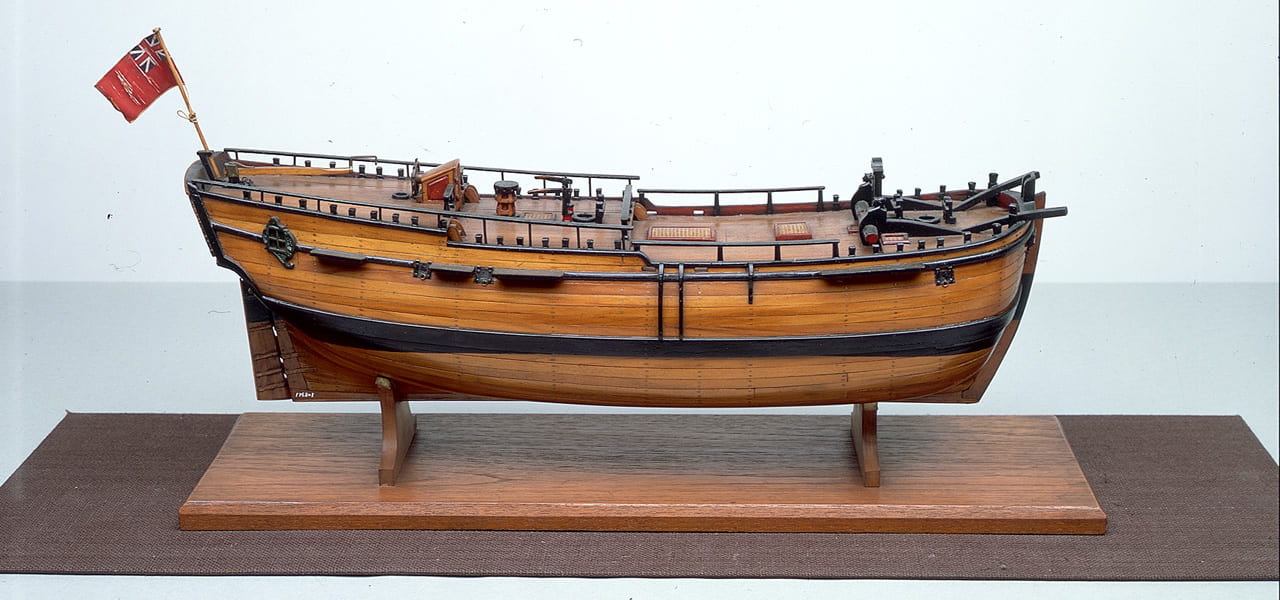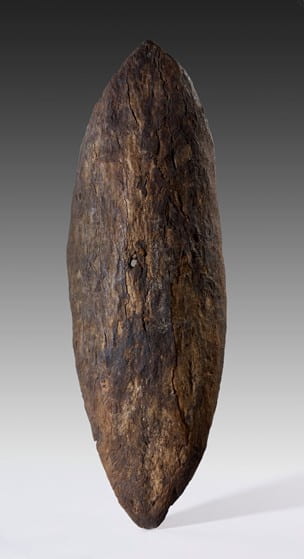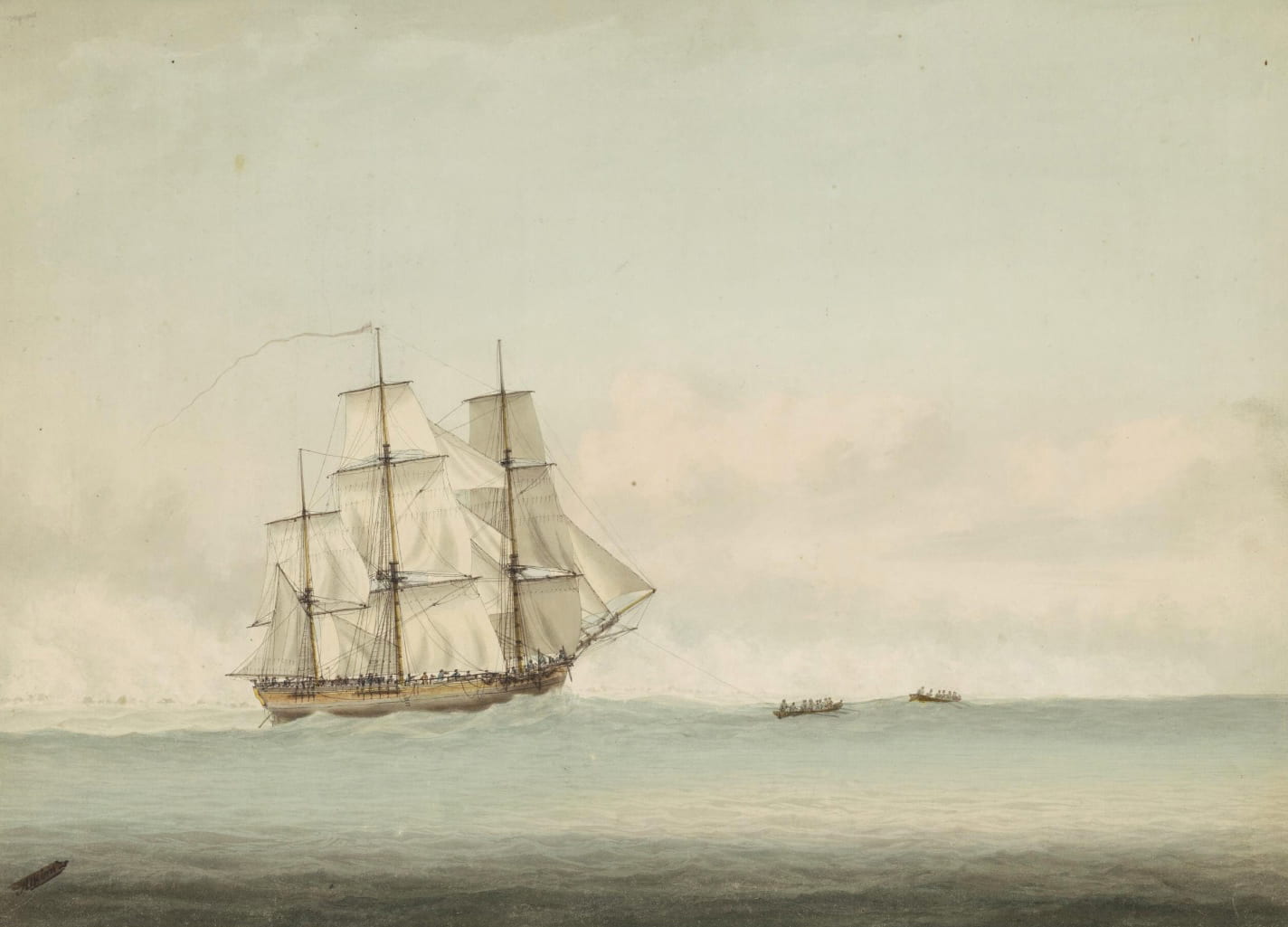By Editor Spencer Weinreich
The great ships of maritime history are protagonists in their own right. That iconic trio of explorers, Nina, Pinta, Santa Maria. That martyr for American imperialism, USS Maine. That scientific trailblazer, HMS Beagle. That bold adventurer, Kon-Tiki. Following the “lives” of these vessels, rather than the lives of those who sailed in them, brings out the sheer diversity of interests and narratives impelling human beings and their craft across the seas, the overlapping imperatives of commerce, science, and power plotting their courses.
The ship seen in Samuel Atkins’s serene painting, now held by the National Library of Australia, began its life in Whitby, North Yorkshire, built by the local shipwright Thomas Fishborne for the merchant Thomas Millner, also of Whitby. Launched in June 1764, the Earl of Pembroke, as the vessel was christened, was a collier, a cargo ship destined to transport the coal of northern England’s mines.

A hull model of the Earl of Pembroke as a collier, National Maritime Museum, Greenwich, London
But the stars—or in this case, the planets—aligned a different way for the Earl of Pembroke. One of the rarest pieces of serendipity that periodically grace our solar system is the Transit of Venus, in which the planet passes in front of the sun so as to be observable from earth, not unlike the passage of the Moon during a solar eclipse. Transits occur in pairs eight years apart, but with one pair separated from another by more than a century. Astronomically, they are as invaluable as they are rare, affording unique opportunities to learn about the workings of the heavens. In the eighteenth century, astronomers hoped to use the Transit to calculate the distance between the Sun and the earth.
Unfortunately, observations of the 1761 Transit were ruined by adverse weather; to the stargazers at the time, the 1769 recurrence became quite literally the chance of a lifetime to conduct such observations. A number of European powers made plans to seize the moment—the dogged French astronomer Guillaume Le Gentil had gone to the Indian Ocean to observe the transit, then hung around for eight years until the next one (see Sawyer Hogg)—including the British Crown. With the king’s backing, the Royal Society and the Royal Navy joined forces to mount an expedition to the Pacific—with the dual purpose of observing the Transit and discreetly exploring and mapping any islands they should encounter along the way.
The Royal Society initially nominated the Scottish geographer Alexander Dalrymple to lead the expedition, but First Lord of the Admiralty Edward Hawke, a decorated war hero entering his forty-eighth year in the service, declared that he would cut off his right hand before he entrusted a naval ship to a civilian with no maritime experience (Westfall and Sheehan, 327). The compromise candidate was a navy lieutenant barely forty years old, fresh from a surveying expedition to Newfoundland with experience making astronomical observations—one James Cook.

William Hodges, Capt. James Cook of the Endeavour (c.1775)
Cook had grown up in Great Ayton, less than thirty miles to the west of Whitby, and began his nautical career as an apprentice to one of Thomas Millner’s competitors, the Quaker coal merchant John Walker, who became a lifelong friend (see Williams, chapter 2). After nine years sailing the North Sea coal routes, Cook enlisted in the navy in 1755, rising rapidly through the ranks. In 1758, he began to learn surveying, and spent the next decade doing cartographic work on the navy’s behalf.
Cook was promoted to lieutenant in May 1768, a high enough rank that he could take sole command of a ship. The vessel in question was, of course, the Earl of Pembroke, which the Navy had purchased from Millner in April, refitted, and renamed HMS Endeavour, the eighth naval ship to bear that name. The choice of the humble collier to undertake so grand a voyage was no mistake: a well-built collier was study, capacious, and highly maneuverable. Vitally, they were designed with shallow hulls, to aid navigation through the rocky coasts of the North Sea, a feature that would prove invaluable when exploring waters whose shallows, reefs, and sandbars were uncharted.
On August 26, a crew of 94, including the naturalist and future president of the Royal Society Joseph Banks, set out from Plymouth. Two weeks into the voyage, the Endeavour arrived at Funchal in the Madeira Islands to take on fresh supplies, something to which Lieutenant Cook paid close attention. It was fortunate for his crew that he did so: the leading cause of death among eighteenth-century sailors was neither cannonshot nor shipwrecks nor sharks, but scurvy.
Scurvy—a debilitating and ultimately fatal deficiency of Vitamin C—was first observed by the Ancient Egyptians circa 1550 BCE. The connection between the condition and one’s intake of fruits and vegetables is one of the most frequently discovered-and-lost pieces of information in human history, learned by numerous sailors and admirals throughout the medieval and early modern period, yet never firmly or widely established in the medical—to say nothing of the popular—consciousness. In 1747, James Lind, a surgeon onboard the ship HMS Salisbury, devised an experiment in which he treated scurvy sailors with a range of supposed cures, among them hard cider, seawater, garlic, mustard seed, and, crucially, oranges and lemons. He found that the latter worked by far the best—but unfortunately for his seagoing contemporaries he buried this discovery in a single paragraph within a long and dull book that very few people read.
Interestingly, among Lieutenant Cook’s various missions was to test the latest theory about scurvy, which held that the condition stemmed from the depletion of the body’s gases and could be prevented with malt and wort, byproducts from the brewing of beer or whisky. As it happened, not a single one of Cook’s crew succumbed to scurvy—an achievement historians credit to the lieutenant’s scrupulous attention to cleanliness and frequent stops to pick up fresh supplies—and he lauded the virtues of malt and wort to his superiors.
The visit to Funchal was not without incident. The Endeavours quatermaster, Alex Weir, was killed when his leg was caught by the anchor cable and he was dragged into the water. Cook simply kidnapped a replacement from the crew of an American ship also in the harbor, a John Thurman of New York, and proceeded on his way (Hough, 62–63). Impressment, the forcible recruitment of sailors, was rife on the eighteenth-century sea, and was shortly to become a flashpoint of the American Revolution. Amid all the scientific investigations, it must not be forgotten that the Endeavour was a military craft, operating with the full authority of the British Navy.
Richard Sorrenson has brilliantly elucidated how ships like the Endeavour were really scientific instruments, tools for mapping coastlines and observing weather conditions. Furthermore, the Endeavour functioned as a “floating laboratory,” from which astronomical observations could be made and natural specimens could be taken. So much so, that Banks arranged for an enormous (and enormously expensive) refit of the collier destined for Cook’s second and third voyages, the HMS Resolution, with an unwieldy deluxe set of scientific apparatus. The changes made the Resolution virtually unsailable, and another small fortune was spent undoing Banks’s grandiose renovations.
All that lay in the future, of course, but even without a specialized ship, Banks and company accomplished a great deal from the Endeavour. Charting a large bay on the eastern coast of Australia, for example, Cook and his crew initially decided upon the name “Stingray Bay,” in honor of the area’s most prominent fauna. But a later version of Cook’s journal states, “The great quantity of plants Mr. Banks and Dr. Solander found in this place occasioned my giving it the name of

Gweagal shield taken on Cook’s voyage, currently held by the British Museum.
A more visceral form of imperial assertion came in the Endeavour‘s violent confrontation with the Gweagal Aborigines. Cook’s crew had several tense encounters with the indigenous inhabitants of what became Botany Bay: when several Gweagal warriors approached, and offerings of gifts proved unsuccessful, Cook shot one of them in the leg. This bit of violence neither cowed the Gweagal nor resulted in further clashes. Alongside the specimens collected by the naturalists, the Endeavour‘s crew made off with several dozen Gweagal spears and shields. These artifacts survive in the collections of several British museums, which have thus far rebuffed claims by the Gweagal for the return of their patrimony.
With the Transit successfully observed and a wealth of cartographic and scientific data gathered to boot, the Endeavour could begin the journey homeward, a journey not without further incident. On June 11, 1770, the collier—shallow hull notwithstanding—had an abrupt encounter with what we know as the Great Barrier Reef. As the ship began to take on water, Cook’s crew threw more than 50 tons of excess weight overboard, including several cannons. High tide freed the Endeavour from the reef, and the ship managed to make it back to mainland Australia for emergency repairs. In 1969, the cannons and other pieces of ballast were recovered from the waters surrounding the aptly named Endeavour Reef.
Nor was this the end of the Endeavour‘s trials: lightning struck the ship in the Dutch East Indies, near what is now Jakarta. Once more, science came to empire’s aid: the mast was equipped with a rudimentary lightning rod, developed less than twenty years previous by Benjamin Franklin, which averted serious damage.
At long last, the Endeavour made it back to Britain on July 12, 1771, where Cook and Banks’s achievements caused a sensation. Plans were afoot for another expedition almost immediately, but this would be made in another converted collier, Resolution. Endeavour was refitted as a transport and spent a few more years in naval service, making several trips between Britain and the Falkland Islands in the South Atlantic.
The fame won by Cook and Banks did not transfer to their vessel, such that the Navy saw no particular reason to keep the Endeavour. In March 1775 it was sold to the merchant James Mather, in whose service the ship made at least one commercial voyage to Russia (see Baines).
Once again, however, the tremors of world history contrived to jolt the Endeavour out of the world of commercial shipping: His Majesty’s American colonies rebelled against the Crown. To prosecute a transatlantic military operation, ships were needed in large quantities, and merchants could make a tidy sum selling vessels to the Navy. Toward the end of 1775, Mather offered the Endeavour back to the Crown, but battered by thousands of miles’ worth of wind, waves, reefs, lightning, and years of wear and tear, the craft was rejected as unseaworthy. Nothing daunted, Mather simply renamed it the Lord Sandwich (presumably a bit of flattery directed as John Montagu, fourth earl of Sandwich and legendarily the inventor of the eponymous foodstuff, who had succeeded Hawke as first lord of the admiralty) and tried again. Again he was refused. This time, Mather deigned to make some repairs to the former collier, and finally succeeded in selling it back to the Royal Navy.
The change in ownership occasioned yet another renaming—there was already a navy ship called the Lord Sandwich—this time to the eminently original Lord Sandwich 2. The Lord Sandwich 2 was dispatched to the colonies, where it served as a transport and as a prison ship in the British occupation of Rhode Island. But on August 4, 1778, with the French navy closing in on Newport harbor, the British commander ordered surplus ships scuttled to blockade the bay—the Lord Sandwich 2 among them.
For nearly two and a half centuries, Captain Cook’s first naval command has been resting on the bottom of Narragansett Bay, a testament in wood and canvass to the inextricable entanglements of warfare, commerce, science, and empire in oceanic history. No single person who sailed on the Endeavour experienced half so much, or shared in all of the projects and ambitions of the ship—demanding that we broaden our historiographical horizon beyond the human. At the same time, the materiality of the ship—the wood, canvass, rope, tar, and the human resources of crew and captain—affirms the materiality of travel, even as the many repairs and reconstructions bely any static notion of an “object.” Like the ship of Theseus, the Endeavour was never a single thing. So much so, that its journeys continue, on the reverse of every New Zealand fifty-cent coin, in full-scale working replicas, and even into outer space, bequeathing its name to the Space Shuttle Endeavour, a NASA orbiter that flew twenty-five missions between 1992 and 2011. Wonderfully, fragments of the original Endeavour‘s timber were carried on the shuttle, and on Apollo 15—callsign “Endeavour”—when it landed on the Moon in 1971 (Wright). Not quite as far as Venus, but not bad for a North Sea collier.

Space Shuttle Endeavour, photographed from the International Space Station in 2010
***
As a coda, let me briefly return to Samuel Atkins’s beautiful painting of the HMS Endeavour off the coast of New Holland. Atkins painted that canvas circa 1794—the ship in question had been resting on the bottom of Narragansett Bay for sixteen years. Though the best years of Britain’s empire are still very much ahead, the loss of the American colonies was a blow to the national psyche. The tranquil grace of the Endeavour, the vehicle for one of the maritime British Empire’s greatest scientific and geographical triumphs, is a potent fantasy in 1794.





Leave a Reply